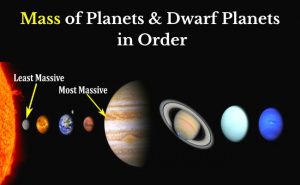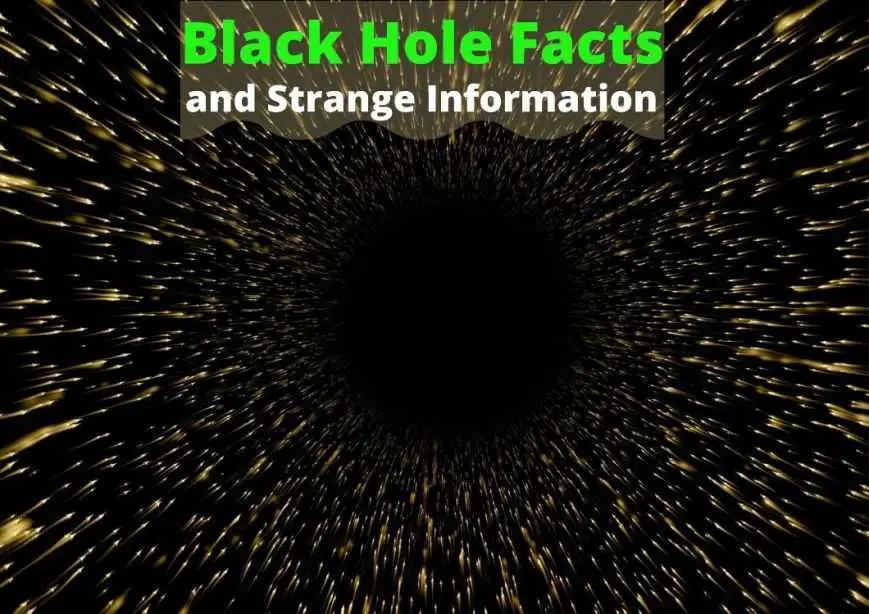A black hole is a region of space-time with strong gravitational force where nothing can escape if comes near it. Due to the strong gravity of the black hole, particles, matter even electromagnetic waves such as light cannot escape from its grip.
According to the general theory of relativity, a strongly compact mass can create enough gravity to deform space-time and thus form a black hole.
Black hole facts
Here are given some strange information and interesting black hole facts:
1. Enormous gravity can pull anything
The density of the black holes is extremely high, that’s why they have enormous gravity. Though black holes do not suck any object until the object comes under the influence of its gravity.
Anything with an escape velocity greater than the speed of light is called a black hole. So, to un-affecting the gravitational pull of the black hole the object must travel at more than light speed.
- Read about:- Gravity and Gravitational Force
2. A black hole can stop time
According to Einstein’s general theory of relativity, time is affected by speed and mass. The more you get closer to the black hole, the more time will slow down.
Once an object enters into a black hole the time will stop for that particular object. We can observe it, like no object returns from the black hole because time has been stopped for that object.
- Read about:- General theory of relativity
3. The black hole itself does not pull anything
There is a misconception that it can pull or suck in interstellar objects like a vacuum cleaner. Though it pulls objects just because of its gravity.
It’s like other space objects. It means the object that has more mass will have more gravity. More gravity results in more gravitational pull, automatically.
For example: Here is a question, what happens if we replace our sun with a black hole of the same mass? The answer is ‘nothing’. As the replaced black hole would have the same mass. That means it may be small in size but the gravitational pull will be the same as our Sun. And orbits of planets and other objects depend on the gravitational pull so they would orbit as usual as it was. So Theoretically, nothing will happen and our solar system will work as usual, though the energy system previously provided by the sun wouldn’t be available.
- Read about:- Revolution of planets around the sun
4. It works as an ideal black body
A black hole does not reflect any light similar to an ideal black body. An ideal black body can absorb every light but does not reflect any. Similarly, a black hole can absorb every light even all objects, and does not reflect any light or does not allow it to go out of any object.
5. Point of no return or event horizon
An event horizon is a region of a boundary inside which no event can be observed by an observer. Every black hole has an event horizon that’s why nothing could be observed so far inside a black hole.
The event horizon lies all around a black hole and is also known as the point of no return. Once anything crosses this point, it can not return back as enormous gravity will pull it inside.

6. Black holes also rotate like stars
There are two types of black according to their rotation, 1. rotating black hole and 2. non-rotating black hole. Rotating black holes are formed when a massive spinning star collapse or a collision of rotating objects, stars, and interstellar gases. These rotating black holes contain angular momentum.
- Read about:- Types of stars
7. Singularity lies at the center of every black hole
According to the theory of general relativity, a singularity is a region where space-time curvature is infinite. Scientists have estimated that this singular region has infinite density.
For a non-rotating black hole, this region lies at a single point. Whereas for rotating black holes this region forms a ring singularity also known as ringularity.
8. Black holes are invisible
One of the common black hole facts is, they are invisible. As lights can not get out no one can see it. They can be found only with the help of some special telescopes. Nearby stars to black holes behave differently compared to normal stars and this effect can help to find them.
9. The massive star forms a stellar black hole
Stellar black holes are formed when a massive star of more than 40 solar masses collapses at the end of its life cycle. After forming, it starts absorbing surrounding objects, and stars and merging with other black holes. Later it may become supermassive black holes with more than millions of solar masses.
10. Most galaxies have black holes at their center
According to scientists, most galaxies have a supermassive black hole at the center of the galaxy. Our milky way galaxy has also a supermassive black hole Sagittarius A*. According to an estimation, Sagittarius A* has a mass of more than 4.3 million suns.
- Read about:- Our galaxy milky way
11. The first image of a black hole
The very first image of a supermassive black hole was taken by the Event Horizon Telescope on 10 April 2019. This black hole lies in the center of the supergiant elliptical galaxy Messier 87.
According to scientists, the mass of this supermassive black hole is around 7 billion solar masses.
12. A black hole may be smaller than the size of an atom
As we know how big and massive a black hole can be. But it can also be a very small size. They can be even smaller than the size of the photons. The world’s largest machine Large Hadron Collider (LHC) is trying to generate a black hole the size of approximately 10-20 grams.
13. Existence of a black hole was proposed in the 18th century
The English clergyman and astronomer John Michell published a letter in 1784 and proposed the idea of massive objects from where nothing can escape, not even light.
He assumed such a massive body can have an escape velocity of more than the speed of light. He also predicts that these massive bodies can be detected via disturbed gravitational effects on nearby objects.
Astronomers found the first black hole in 1970 and it was called Cygnus X-1. Cygnus X-1 is a stellar black hole and a galactic X-ray source. It is located approximately 6000 light-years away from us in the constellation Cygnus.
Types of Black Holes
According to the mas and size, black holes are divided into four categories:
- Supermassive black hole
- Intermediate mass black hole
- Stellar black hole
- Micro black hole
Supermassive black holes
These types of black holes are the most massive ones and can have the mass of millions or even billions of Sun. This type of black hole lies at the center of the supergiant galaxy. Their size can range from 0.001 to 800 AU.
Intermediate mass black holes (IMBHs)
This type of black hole is smaller than supermassive black holes but is larger than stellar black holes. Their sizes may be in the range of 1000 km or approximately the size of the earth. But the mass of these black holes may be a million times the earth’s mass or 1000 times the solar mass.
- Read about:- Facts about Earth
Stellar black holes
When a supermassive star collapse at the end of its life cycle then stellar black holes are formed. These black holes are smaller and can be in the range of around 30 km in size. But the mass of these types of black holes can be up to 10 solar masses.
Micro black holes
These types of black holes can have a size of o.1 mm. Whereas some scientist believes their size can be as small as the size of a photon. But they are quite massive compared to their size and can be equal to the mass of the moon or earth.
So, these were some informative black hole facts. Hope you have got to know about one of the most strange regions in our space. To know more you can check the below articles:-
- 5 Best Solar System Backpacks in 2024

- Mass of Planets in Order from Lightest to Heaviest

- Star Projector {2024}: Star Night Light Projector


